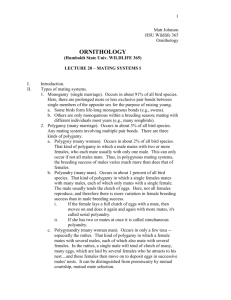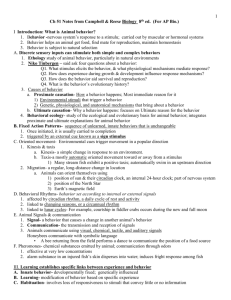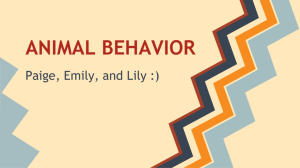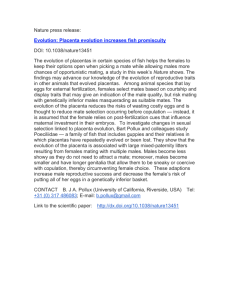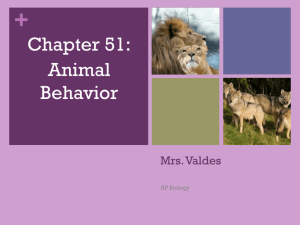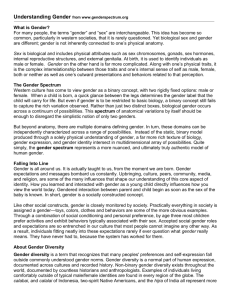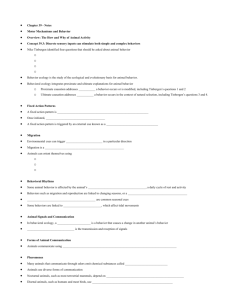Chapter 46 Notes (Behavior Ecology) Overview: Studying Behavior
advertisement
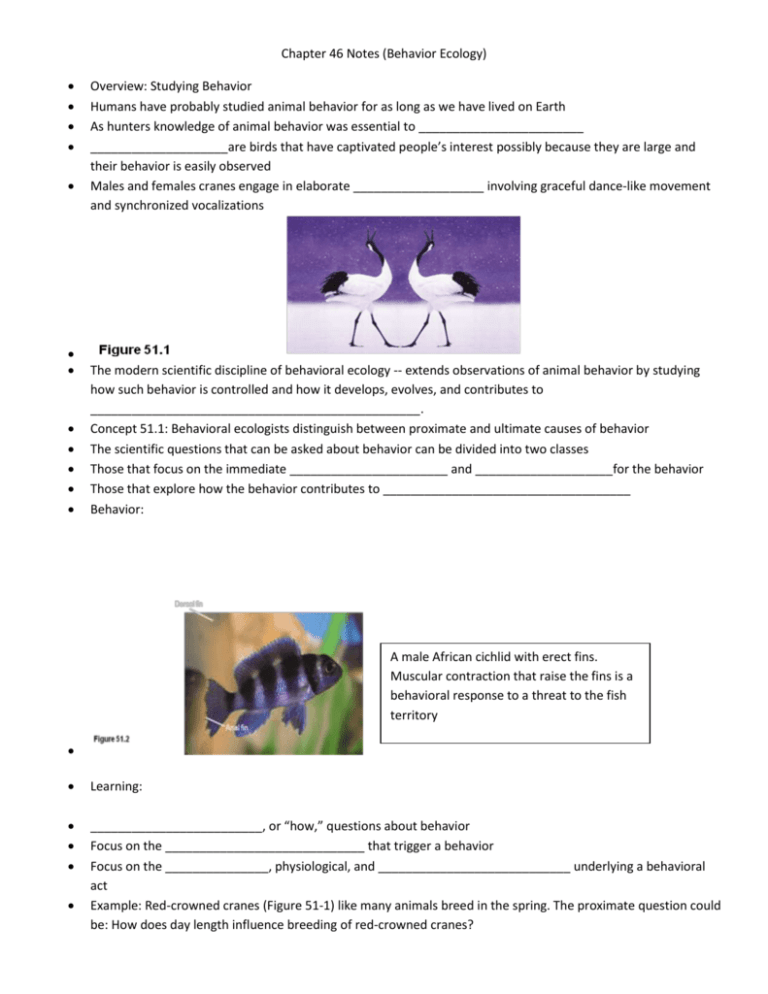
Chapter 46 Notes (Behavior Ecology) Overview: Studying Behavior Humans have probably studied animal behavior for as long as we have lived on Earth As hunters knowledge of animal behavior was essential to ________________________ ____________________are birds that have captivated people’s interest possibly because they are large and their behavior is easily observed Males and females cranes engage in elaborate ___________________ involving graceful dance-like movement and synchronized vocalizations The modern scientific discipline of behavioral ecology -- extends observations of animal behavior by studying how such behavior is controlled and how it develops, evolves, and contributes to ________________________________________________. Concept 51.1: Behavioral ecologists distinguish between proximate and ultimate causes of behavior The scientific questions that can be asked about behavior can be divided into two classes Those that focus on the immediate _______________________ and ____________________for the behavior Those that explore how the behavior contributes to ____________________________________ Behavior: A male African cichlid with erect fins. Muscular contraction that raise the fins is a behavioral response to a threat to the fish territory Learning: _________________________, or “how,” questions about behavior Focus on the _____________________________ that trigger a behavior Focus on the _______________, physiological, and ____________________________ underlying a behavioral act Example: Red-crowned cranes (Figure 51-1) like many animals breed in the spring. The proximate question could be: How does day length influence breeding of red-crowned cranes? Ultimate Question ____________________, or “why,” questions about behavior Address the ___________________________ of a behavior Example: Why did natural selection favor this behavior and not a different one? Ethology: Mid 20th-century ethologists developed a conceptual framework defined by a set of questions These questions highlight the complementary nature of _____________________________ perspectives Fixed Actions Patterns A fixed action pattern (FAP) Is a sequence of unlearned, ________________________ that is unchangeable Once initiated, is usually carried to __________________________ A FAP is triggered by an external sensory stimulus known as a ____________________________ In male stickleback fish, the stimulus for __________________ behavior-- is the red underside of an ____________________ When presented with unrealistic models As long as some red is present, the _______________________ behavior occurs Proximate and ultimate causes for the FAP attack behavior in male stickleback fish BEHAVIOR: A male stickleback fish attacks other male sticklebacks that invade its nesting territory. PROXIMATE CAUSE: The red belly of the intruding male acts as a sign stimulus that releases aggression in a male stickleback. ULTIMATE CAUSE: By chasing away other male sticklebacks, a male decreases the chance that eggs laid in his nesting territory will be fertilized by another male. Imprinting: Imprinting is distinguished from other types of learning by a _________________________ A _______________________ in an animal’s development that is the only time when certain behaviors can be learned An example of imprinting is __________________________ following their mother _______________________________ showed that: When baby geese spent the first few hours of their life with him, they imprinted on him as their parent There are proximate and ultimate causes for this type of behavior BEHAVIOR: Young geese follow and imprint on their mother. PROXIMATE CAUSE: During an early, critical developmental stage, the young geese observe their mother moving away from them and calling. ULTIMATE CAUSE: On average, geese that follow and imprint on their mother receive more care and learn necessary skills, and thus have a greater chance of surviving than those that do not follow their mother. Conservation biologists have taken advantage of imprinting In programs to save the _____________________________________ from extinction Concept 51.2: Many behaviors have a strong ____________________________component Biologists study the ways both _____________ and the ________________________ influence the development of ________________________________ Behavior that is developmentally fixed Is called _________________________ and is under strong genetic influence Direct Movements Many animal movements are under substantial ____________________ These types of movements are called _______________________ Kinesis Kinesis: Sow bugs become more active in _______________________ and less active in _______________________ Taxis Taxis: Many stream fish exhibit positive ___________________________ (rheos – Greek for current) Where they automatically swim in an __________________________ direction Migration Many features of migratory behavior in birds have been found to be _________________________programmed Animal Signals and Communication In behavioral ecology: A signal is a behavior that causes a change in another __________________________ Communication: Animals communicate using ____________________________________________________ The type of signal used to transmit information is closely related to an animal’s _________________ and _______________________________. Chemical Communications Many animals that communicate through odors-- emit chemical substances called ______________________ When a minnow or catfish is injury an alarm substance in the fish’s skin disperses in the water, inducing a ______________________________________ among fish in the area Auditory communications Experiments with various insects have shown that courtship songs are under _____________________________ Genetic Influences on Mating and Parental Behavior Research has revealed the ______________ and _______________ basis for the mating and parental behavior of male prairie voles Prairie voles are monogamous and help with the nurturing of young, which is very uncommon in mammals Concept 51.3: Environment, interacting with an animal’s ____________________________, influences the development of behaviors Research has revealed that environmental conditions modify many of the same behaviors Dietary Influence on Mate Choice of Behavior One example of _________________________ on behavior Is the role of diet in __________________ by Drosophila mojavensis (Fruit Fly) Laboratory experiments have demonstrated that the type of food eaten during _______________________________ influences later mate choice in females Therese Markow and Eric Toolson proposed that the physiological basis for the observed mate preferences was differences in __________________________ in the exoskeletons of the flies Social Environment and Aggressive Behavior Cross-fostering studies in California mice and white-footed mice have uncovered an influence of social environment on the aggressive and parental behaviors of these mice Influence of cross-fostering on male mice Learning Learning: Learned behaviors range from very __________________ to very ______________________ Habituation: Spatial Learning: In a classic experiment, Niko Tinbergen showed how ________________________use landmarks to find the entrances to their nests Cognitive map: Associative Learning: ____________________________________ is a type of associative learning in which an arbitrary stimulus is associated with a reward or punishment Example: Pavlov dog experiment _________________________________ is another type of associative learning (also called trial and error learning) In which an animal learns to associate one of its behaviors with a ______________________ or __________________________and then tends to repeat or avoid that behavior Having received a face full of quills a young coyote has probably learned to avoid porcupines Cognition and Problem Solving Cognition : Problem solving can be learned by ___________________________ the behavior of other animals Chimpanzees learning to crack oil palm nuts by observing an experienced chimpanzees ____________________________ and ___________________________ can interact to influence the learning process of complex behavior Concept 51.4: Behavioral traits can evolve by ___________________________ Because of the influence of ____________________on behavior Natural selection can result in the_____________________________ of behavioral traits in populations When _______________________variation within a species corresponds to variation in the environment, it may be evidence of past evolution Variation in Prey Selection Differences in prey selection in populations of garter snakes are due to _______________________ and are evidence of __________________________ _______________________: behavior associated with recognizing, searching for, capturing, and consuming food. Garter snake will eat different based on where the snake is living (coastal versus inland) Variations in Aggressive Behavior Funnel spiders living in different habitats exhibit differing degrees of ___________________ in defense and foraging behavior Aggressiveness of funnel web spiders from different environments. The arid environments delay less before attacking because of having less food Laboratory and field experiments can demonstrate the _______________________ of behavior Studies of Drosophila populations raised in high- and low-density conditions show a clear __________________in behavior linked to specific genes Migratory Patterns in Backcaps Field and laboratory studies of Blackcap birds have documented a change in their ____________________ behavior Birds placed in funnel cages left marks indicating the _______________________ they were trying to migrate __________________________ orientation of wintering adult birds captured in Britain was very similar to that of laboratory-raised birds Concept 51.5: ______________________ favors behaviors that increase survival and reproductive success The__________________________ components of behavior evolve through natural selection Behavior can affect ______________________________ through its influence on foraging and mate choice Foraging Behavior Optimal foraging theory views foraging behavior as a compromise between the benefits of _______________ and the ___________________ of obtaining food Such as the _____________________ or risk of being eaten by a ______________________ while foraging. Reto Zach conducted a cost-benefit analysis of _______________________ in crows The crows eat molluscs called ________________________ but must drop them from the air to crack the shells Zach determined that the optimal flight height in foraging behavior-correlated with a fewer number of drops, indicating a trade-off between ________________________________ (food) and _________________________ In bluegill sunfish prey selection behavior is related to _______________________________ In feeding on water fleas the fish do not feed randomly but select prey based on both size and distance, tending to pursue prey that looks largest Research on mule deer populations has shown that _________________________ affects where the deer choose to ___________________ Optimal foraging theory predicts that prey will forage in a way that minimizes the risks of predation. The risk of predation by mountain lions is lowest in open areas and forest interiors and highest in forest edges Mating behavior __________________________________, which includes seeking or attracting mates, choosing among potential mates and competing for mates. Is the product of a form of natural selection called _______________________________ The __________________________ relationship between males and females varies a great deal from species to species In many species, mating is ______________________________ with no strong pair-bonds or lasting relationships In _______________________________ relationships one male mates with one female In a system called ______________________________ one male mates with many females The males are often more ______________________ and larger than the females In polyandrous systems, one ______________________ mates with many males The females are often more ____________________ than the males The needs of the young are an important factor constraining the evolution of ____________________ systems The certainty of paternity influences _________________________ and ________________ behavior In species that produce ________________________________ of offspring parental care is at least as likely to be carried out by _________________________ as females Parental care by a male jawfish. Male jawfish live in tropical marine environments, hold they have fertilized in their mouths, keeping them aerated and protecting them from egg predators Sexual Selection In _______________________________ members of one sex choose mates on the basis of particular characteristics Example: __________________________ Intrasexual selection involves ____________________________ among members of one sex for mates Mate Choice by Females Male zebra finches are more ______________________ than females, a trait that may affect mate choice by the females _____________________________ of female chicks on males with more ornamentation affects mate selection as adults The ______________________________ in stalk-eyed flies affects which males the females choose to mate with Male Competition for Mates Agonistic behavior : Such competition may involve agonistic behavior (an often ________________________________ that determines which competitor gains access to a resource) An often ritualized contest that determines which competitor gains access to a _______________________ ________________________________ affects the mating behavior In __________________________ of the same species that are genetically distinct _______________________________ evaluates alternative behavioral strategies in situations where the outcome depends on each individual’s strategy and the strategy of other individuals _________________________success of male side-blotched lizards was found to be influenced by male polymorphism and the abundance of different males in a given area 1st (Orange throat lizard) most aggressive and defend territory (More females) 2nd (Blue throat lizard) also territorial but defend a smaller territories (Fewer females) 3rd (Yellow throat lizard) Nonterritorial males that mimic females and use “sneaky” tactics to obtain mating Concept 51.6: The concept of inclusive fitness can account for most __________________________ social behavior Many social behaviors are __________________________ ________________________________ favors behavior that maximizes an individual’s survival and reproduction On occasion, some animals Behave in ways that reduce their individual fitness but increase the fitness of _________________________ This kind of behavior is called _____________________________________, or selflessness In naked mole rat populations-- _____________________individuals may sacrifice their lives protecting the _______________________ individuals from predators The naked mole rat (nearly hairless and blind) lives in colonies of 75 to 250 + individuals. Each colony only has one queen who mates with one to three kings. The rest are nonreproductive males and females that forage for underground roots and tubers. The nonreproductive rats sacrifice their own lives to protect their queens and kings Inclusive Fitness Altruistic behavior can be explained by ________________________________________the total effect an individual has on proliferating its genes by producing its own offspring and by providing aid that enables close relatives to produce ________________________________ Hamilton’s Rule and Kin Selection Hamilton proposed a quantitative measure for predicting when ____________________________ would favor altruistic acts among related individuals The three key variables in an altruistic act are 12- 3- The ________________________________________ is the probability that two relatives may share the same genes _________________________________ favors altruism when the benefit to the recipient multiplied by the coefficient of relatedness exceeds the cost to the altruist This inequality is called ____________________________________ Kin selection is the natural selection that favors this kind of altruistic behavior by enhancing ______________________________________ of relatives An example of kin selection and altruism is the ____________________________ observed in Belding’s ground squirrels Reciprocal Altruism ________________________________ toward unrelated individuals can be adaptive if the aided individual returns the favor in the future This type of altruism is called _____________________ Social Learning Social learning forms the roots of culture Culture can be defined as a system of information transfer through ___________________________or teaching That influences the behavior of _______________________ in a population Mate Choice Copying __________________________________________ is a behavior in which individuals in a population copy the mate choice of others This type of behavior has been extensively studied in the guppy Poecilia reticulata Vervet monkeys produce a complex set of ______________________________ when they see a leopard, eagles or snake Infant monkeys give undiscriminating _____________________________ at first but learn to fine-tune them by the time they are adults Humans Behavior No other species comes close to matching the social learning and cultural transmission that occurs among ____________________________ ______________________________ is related to evolutionary theory in the distinct discipline of sociobiology Human behavior, like that of other species is the result of interactions between genes and environment However, our ___________________and_________________________institutions May provide the only feature in which there is no continuum between humans and other animals


